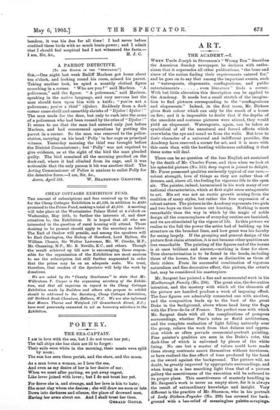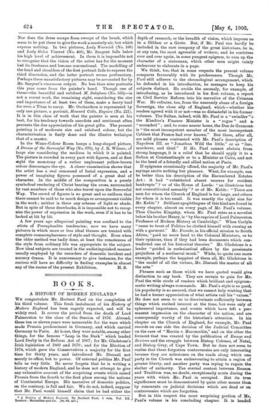ART.
THE ACADEMY.—I.
WHEN Uncle Joseph in Stevenson's " Wrong Box" describes the American Sunday newspaper, he declares with enthu- siasm that it supersedes all other publications, "the bone and sinew of the nation finding their requirements catered for," and he goes on to say that among the important events, such as " waterspouts, elopements, conflagrations, and public
entertainments even literature " finds a corner. With but little alteration this description can be applied to the Academy. It needs but a small stretch of the imagina- tion to find pictures corresponding to the " conflagrations and elopements." Indeed, in the first room, Mr. Dicksee gives flesh colour which can only be the result of a house on fire ; and it is impossible to doubt that if the depths of the anecdote and costume pictures were stirred, they would yield an elopement. Waterspouts, again, can be taken as symbolical of all the unnatural and forced effects which overwhelm the eye and assail us from the walls. But true to their character of a universal and indifferent provider, the Academy have reserved a corner for art, and it is more with this oasis than with the howling wilderness enfolding it that these notes will deal.
There can be no question of the loss English art sustained by the death of Mr. Charles Furse, and thus when we look at his splendid picture (No. 515) deep regret is joined to delight. Mr. Purse possessed qualities eminently typical of our race,— robust strength, love of things as they are rather than of dreams, and, above all, the feeling for vigorous life in the open air. The painter, indeed, harmonised in his work many of our national characteristics, which at first sight seem antagonistic to art. His art was not an exotic growth arising from the coalition of many styles, but rather the free expression of a robust nature. The picture in the Academy represents two girls and two boys on their horses out hunting. Nothing is more remarkable than the way in which by the magic of noble design all the commonplaces of everyday routine are banished, and we are stimulated by the vigour of life. In this picture we realise to the full the power the artist had of building up his structure on the broadest lines, and how great was his faculty for seeing largely. If the grouping and general design of the picture first claim attention, it is not because other qualities are less remarkable. The painting of the figures and of the horses is at once brilliant and sincere,—nothing is done for show. True characterisation is to be found in the heads, including those of the horses, for these are as distinctive as those of their riders. From its successful combination of vigorous naturalism and fine decorative effect, this picture, the artist's last, may be considered his masterpiece.
Mr. Sargent has painted a fine and monumental work in his Marlborough Family (No. 256). The great size, the decorative intention, and the mastery with which all the elements of the picture are handled produce a work of imposing effect. The four figures are admirably connected one with another, and the composition leads up to the bust of the great Duke in the background, above whose head hang the flags with the Fleur-de-lis of France. The perfect ease with which Mr. Sargent deals with all the complications of pompons surroundings, whether Peer's robes or florid architecture, and the complete realisation of light falling naturally over the group, relieve the work from that dulness and oppres- sion which so often pervade ceremonial-portrait painting, Fine painter's qualities are seen in the Duke's robe, the dark-blue of which is enlivened by pieces of the white lining. No one but a master of values could have made these strong contrasts assert themselves without harshness, or have realised the fine effect of tone produced by the hand on the sword against the background. The picture will, no doubt, be greatly improved by appropriate surroundings, and when hung in a leas searching light than that of a picture gallery the assertiveness of the execution will be softened to its proper place. This assertiveness of masterly handling in Mr. Sargent's work is never an empty show, for it is always the result of extraordinary knowledge and insight. Very different is the practice of Mr. Shannon, who in his portrait Iof Lady Dickson-Poynder (No. 299) has covered the back. ground with a bas-relief of meaningless palette-scrapings.
Nor does the dress escape from sweeps of the brush, which seem to be put there to give the work a masterly air, but which express nothing. In two pictures, Lady Warwick (No. 168) and Lady Helen. Vincent (No. 460), Mr. Sargent falls below his high level of achievement. In them it is impossible not to recognise that the vision of the artist has for the moment lost its freshness and become conventional. The modelling of the head and shoulders of the first portrait fails to express the third dimension, and the latter portrait seems perfunctory. Perhaps these unsatisfactory pictures may be accounted for by Mr. Sargent's enormous output. No less than nine portraits this year come from the painter's hand. Though one of these—the beautiful and subdued M. Delafosse (No. 553)—is not a recent work, the remaining eight, considering the size and importance of at least two of them, make a heavy load for even a Titan to carry. Mr. Orchardson is represented by only one picture, a portrait, Howard Colls, Esquire (No. 221). It is in this class of work that the painter is seen at his best, for his tendency towards anecdote and sentiment often prevents the due appreciation of his great gifts. The present painting is of moderate size and subdued colour, but the characterisation is finely done and the illusive technique that of a master.
In the Water-Colour Room bangs a long-shaped picture, A Dream of the Sorrowful Way (No. 970), by J. R. Wilmer, of large size considering the medium in which it is painted. The picture is crowded in every part with figures, and at first sight the monotony of a rather unpleasant yellow-brown colour discourages the eye. A closer examination shows that the artist has a real command of facial expression, and a power of imagining figures possessed of a great deal of character. In the middle of the composition is a purely symbolical rendering of Christ bearing the cross, surrounded by vast numbers of those who also travel upon the Sorrowful Way. The crowd of figures is so great and so uniform that there cannot be said to be much design or arrangement visible in the work ; neither is there any scheme of light or shade. But in spite of these drawbacks, it is impossible not to recog- nise the power of expression in the work, even if it has to be looked at bit by bit.
A few years ago allegorical painting was confined to the atists of Preraphaelite tendencies ; now we have many pictures in which more or less ideal themes are treated with complete commonplaceness of style and thought. Even when the older method was badly done, at least the remoteness of the style from ordinary life was appropriate to the subject. Now ideal subjects are treated in the undistinguished manner usually employed by the recorders of domestic incident and nursery dram& It is unnecessary to give instances, for the curious will have no difficulty in finding examples in almost











































 Previous page
Previous page